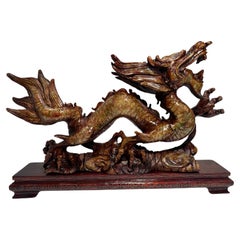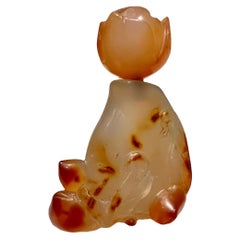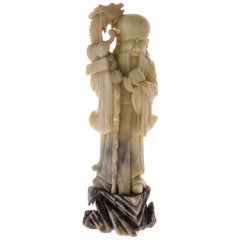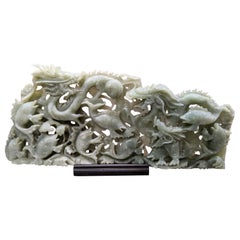Carnelian Sculptures and Carvings
2
to
1
1
2
2
2
1
1
1
36
1,842
1,262
919
887
2
2
2
Material: Carnelian
Year of the Dragon Elaborate Hand Carved Stone Dragon Sculpture on Rosewood Base
Located in Tustin, CA
Intricately hand carved from a single block of richly variegated stone, this incredibly detailed and elaborate, Chinese sculpture is a true work of art. It features a dragon on a car...
Category
Mid-20th Century Chinese Chinese Export Carnelian Sculptures and Carvings
Materials
Stone, Carnelian
A Magnificent Chinese Carnelian Agate Snuff Bottle. Qing Dynasty
Located in London, GB
A Magnificent Chinese Carnelian Agate Snuff Bottle. Qing Dynasty.
Antique Chinese Carnelian Agate Hand Carved Snuff Bottle finely carved in...
Category
Late 19th Century Chinese Antique Carnelian Sculptures and Carvings
Materials
Agate, Carnelian
Related Items
Chinese Carved Soap Stone Sculpture of a Wise Ancient with Dragon
Located in Frankfurt am Main, DE
A finely carved soap stone sculpture of a wise ancient with a dragon on his shoulder standing on a braun soap stone base. In fine original conditi...
Category
Early 20th Century Chinese Carnelian Sculptures and Carvings
Materials
Stone
Large Chinese Nephrite Jade Stone Sculpture Hand Carved Fine Art Dragons Statue
Located in Greer, SC
Stunning large Chinese hand carved genuine jade sculpture (tested as nephrite jade) depicting dragons and koi fish. The original owner provided details that this sculpture was create...
Category
Late 19th Century Chinese Qing Antique Carnelian Sculptures and Carvings
Materials
Jade
H 13 in W 30 in D 2.25 in
Antique Victorian Religious Chinese Export Ivory Bone Carved Pagoda Sculpture
Located in Dublin, Ireland
A Very Fine Quality Chinese Export Hand Carved Religous Pagoda of traditional architectural form and generous proportions, late Nineteenth Century.
The overall structure beautifull...
Category
Late 19th Century Chinese Victorian Antique Carnelian Sculptures and Carvings
Materials
Bone
H 11 in W 4 in D 3.5 in
A pair of 19th Century carved Foo temple dogs or Chinese guardian Lions
Located in London, GB
Chinese guardian lions, or imperial guardian lions, are a traditional Chinese architectural ornament. Typically made of stone, they are also known as stone lions or shishi (石獅; shíshī). They are known in colloquial English as lion dogs or foo dogs / fu dogs. The concept, which originated and became popular in Chinese Buddhism, features a pair of highly stylized lions—often one male with a ball and one female with a cub—which were thought to protect the building from harmful spiritual influences and harmful people that might be a threat. Used in imperial Chinese palaces and tombs, the lions subsequently spread to other parts of Asia including Japan (see komainu), Korea, Philippines, Tibet, Thailand, Myanmar, Vietnam, Sri Lanka, Nepal, Cambodia, Laos, and Malaysia.
There has been extensive interaction between Chinese mythology and Confucianism, Taoism, and Buddhism. Elements of pre-Han dynasty mythology such as those in Classic of Mountains and Seas were adapted into these belief systems as they developed (in the case of Taoism), or were assimilated into Chinese culture (in the case of Buddhism). Elements from the teachings and beliefs of these systems became incorporated into Chinese mythology. For example, the Taoist belief of a spiritual Paradise became incorporated into mythology as the place where immortals and deities used to dwell. Sometimes mythological and religious ideas have become widespread across China's many regions and diverse ethnic societies. In other cases, beliefs are more limited to certain social groups, for example, the veneration of white stones by the Qiang. One mythological theme that has a long history and many variations involves a shamanic world view, for example in the cases of Mongolian shamanism among the Mongols, Hmong shamanism among the Miao people, and the shamanic beliefs of the Qing dynasty from 1643 to 1912, derived from the Manchus. Politically, mythology was often used to legitimize the dynasties of China, with the founding house of a dynasty claiming a divine descent.
Mythology and philosophy.
Further information: Chinese philosophy
True mythology is distinguished from philosophical treatises and theories. Elaborations on the Wu Xing are not really part of mythology, although belief in five elements could appear. The Hundred Schools of Thought is a phrase suggesting the diversity of philosophical thought that developed during the Warring States of China. Then, and subsequently, philosophical movements had a complicated relationship with mythology. However, as far as they influence or are influenced by mythology, divides the philosophical camps into two rough halves, a Liberal group and a Conservative group. The liberal group being associated with the idea of individuality and change, for example as seen in the mythology of divination in China, such as the mythology of the dragon horse that delivered the eight bagua diagrams to Fu Xi, and methods of individual empowerment as seen in the Yi Jing (Book of Changes). The Liberal tendency is towards individual freedom, Daoism, and Nature. The relationship of the Conservative philosophies to mythology is seen in the legendary Nine Tripod Cauldrons, mythology about the emperors and central bureaucratic governance, Confucianism, written histories, ceremonial observances, subordination of the individual to the social groups of family and state, and a fixation on stability and enduring institutions. The distinction between the Liberal and Conservative is very general, but important in Chinese thought. Contradictions can be found in the details, however these are often traditional, such as the embrace by Confucius of the philosophical aspects of the Yi Jing, and the back-and-forth about the Mandate of Heaven wherein one dynasty ends and another begins based according to accounts (some of heavily mythological) where the Way of Heaven results in change, but then a new ethical stable dynasty becomes established. Examples of this include the stories of Yi Yin, Tang of Shang and Jie of Xia or the similar fantastic stories around Duke of Zhou and King Zhou of Shang.
Mythology exists in relationship with other aspects of society and culture, such as ritual. Various rituals are explained by mythology. For example, the ritual burning of mortuary banknotes (Hell Money), lighting fireworks, and so on.
A good example of the relationship of Chinese mythology and ritual is the Yubu, also known as the Steps or Paces of Yu. During the course of his activities in controlling the Great Flood, Yu was supposed to have so fatigued himself that he lost all the hair from his legs and developed a serious limp. Daoist practitioners sometimes incorporate a curiously choreographed pedal locomotion into various rituals. Mythology and practice, one explains the other: in these rituals, the sacred time of Yu merges with the sacral practice of the present.
Various ideas about the nature of the earth, the universe, and their relationship to each other have historically existed as either a background or a focus of mythologies. One typical view is of a square earth separated from a round sky by sky pillars (mountains, trees, or undefined). Above the sky is the realm of Heaven, often viewed of as a vast area, with many inhabitants. Often the heavenly inhabitants are thought to be of an "as above so below" nature, their lives and social arrangements being parallel to those on earth, with a hierarchical government run by a supreme emperor, many palaces and lesser dwellings, a vast bureaucracy of many functions, clerks, guards, and servants. Below was a vast under ground land, also known as Diyu, Yellow Springs, Hell, and other terms. As time progressed, the idea of an underground land in which the souls of the departed were punished for their misdeeds during life became explicit, related to developments in Daoism and Buddhism. The underground world also came to be conceived of as inhabited by a vast bureaucracy, with kings, judges, torturers, conductors of souls, minor bureaucrats, recording secretaries, similar to the structure of society in the Middle Kingdom (earthly China).
Chinese temple Dogs...
Category
1860s Chinese Chinese Export Antique Carnelian Sculptures and Carvings
Materials
Hardwood
H 11.42 in W 20.48 in D 7.49 in
Chinese White Jade Open Late Qing Dynasty Plaque
By Alba China
Located in Gainesville, FL
Chinese white jade openwork plaque late Qing Dynasty depicting birds and flowers. Very fine and detailed work. Small loss on the back side of the pl...
Category
19th Century Chinese Chinese Export Antique Carnelian Sculptures and Carvings
Materials
Jade
Beautiful Chinese fan of Canton of the 19th Century
Located in Saint-Ouen, FR
Beautiful Chinese fan of Canton of the 19th century in Bone, Paper and Silk.
Dimensions: H: 49cm, W: 28cm, D: 2cm.
Category
19th Century Chinese Chinese Export Antique Carnelian Sculptures and Carvings
Materials
Bone, Silk
Chinese Dragon Telephone, circa 1980s
Located in New York, NY
A very beautiful, rare, and exotic Chinese dragon landline telephone, circa 1980s-1990s. Phone is a hard carved wood with all the details of a dragon (claws, tongue, horns, tail, etc.) Phone handle has a beautiful oval piece of polished emerald green jade or other similar stone along with carvings in Chinese. A 'red' light on top of dragon's pearl indicates phone is 'on'. Dragon's green eyes light up when phone rings...
Category
Late 20th Century Chinese Carnelian Sculptures and Carvings
Materials
Jade
Ancient Rare India Wood Hand Carved Polychrome Wall Panel with Iron Lock
Located in Vero Beach, FL
Ancient rare India wood hand carved polychrome wall panel with iron lock.
Exciting and dramatic wood carving of a wall panel from India. It is probably from the 17th-18th century. Very heavy exotic wood is used to hand carve the frame with the double sliding door. It is secured with an iron lock. A carved guardian figure is placed on each side. The frame and doors are polychrome decorated. It is a piece of ancient India...
Category
18th Century Indian Other Antique Carnelian Sculptures and Carvings
Materials
Wood
Antique Chinese Cloisonne Enameled Carved Guanyin Quan Yin Sculpture Figurine
Located in San Diego, CA
Stunning Chinese Guanyin cloisonné enameled figurine/sculpture. Comes with the original wood stand. Hands and head are carved. Stunning color...
Category
1920s Chinese Vintage Carnelian Sculptures and Carvings
H 8.5 in W 3 in D 2.75 in
Antique Asian Chinese Horn Dragons Head Victorian Vintage Walking Stick Cane
Located in Dublin, Ireland
Very Unusual Horn Sectional Hand Carved Chinese Walking Stick or Dress Cane of outstanding quality, last half of the Nineteenth Century.
The ...
Category
Late 19th Century Chinese Victorian Antique Carnelian Sculptures and Carvings
Materials
Sterling Silver
Pair of Chinese Qing Dynasty Openwork Wall Hanging Giltwood Carvings
Located in Vero Beach, FL
Antique pair of Chinese 18th century Qing dynasty openwork wood carving
Gilded screen work wall hanging architectural elements.
This pair of Chinese pan...
Category
19th Century Chinese Qing Antique Carnelian Sculptures and Carvings
Materials
Giltwood
Large Wood Carved Otafuku, Goddess of Mirth, Japanese, Early 20th Century
Located in Point Richmond, CA
Large wood carved Otafuku , Goddess of Mirth, Japanese, 20th Century.
Sometimes known as Okame, a beloved and popular symbol in Japanese culture. With plump cheeks and joyful smile...
Category
Early 20th Century Japanese Other Carnelian Sculptures and Carvings
Materials
Wood
Read More
12 Calming Spaces Inspired by Japanese Design
From cherry-blossom-adorned walls paired with glamorous lighting to wood-paneled ceilings above checkerboard-patterned chairs, these 12 spaces seamlessly blend Eastern and Western aesthetics.
Rodrigo Rivero Lake’s Mexico City Showroom Is a Museum-Worthy Trove of Spanish Colonial and Asian Antiques
The dealer and curator has spent the past 50 years amassing a collection of exceptional art, furniture and architectural elements that trace the cultural influence of the Spanish empire from Europe to the Americas and beyond.
Recently Viewed
View AllMore Ways To Browse
Meiji Netsuke
Carved Ganesh
Jadeite Foo Dogs
Antique White Garden Ornaments
Han Yang
Wayang Marionette
Inuit Drum Art
Seated Guanyin
Bugaku Mask
Burmese Votive
Monkey Ceramic Japanese
Rock Crystal Buddha
Spinach Jade Bird
Bone Carved Chicken
Bronze Budai
Cedar Antique Outdoor Furniture
Jade Scepter
Paper Mache Buddha



